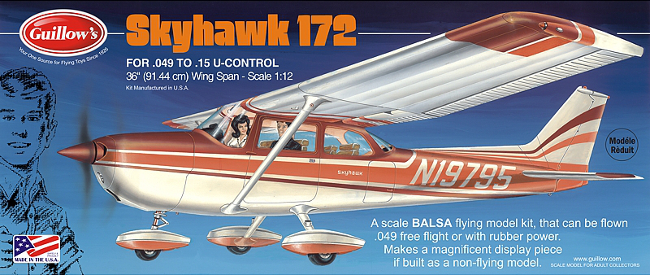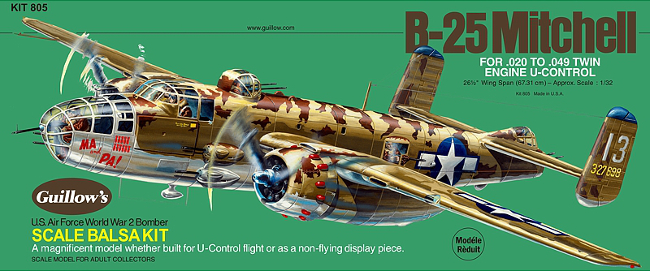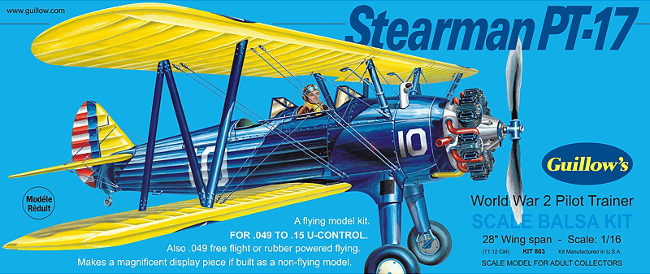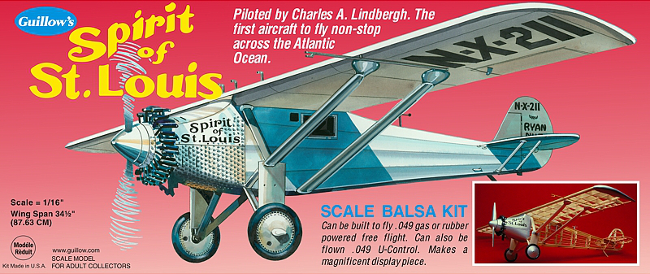
Information and Orders: 1-406-259-9004
Hours: Mon - Sat 10-6 MST
Central Hobbies
1401 Central Avenue
Billings, MT 59102
We Gladly Accept:

as well as

WOOD MODELS : AIRPLANES
No Flat Rate Shipping on these items.
Shipping cost will vary by dimensions or weight.
Please call or email for shipping quotes.

Balsa Wood Airplane Kits
- Page 4 of 7 | 79 Total Products

Zivko Edge 540
Description:
Laser Cut Wood Airplane Kit
Scale: 1/14
Wing Span: 20-3/16"
The Edge 540 is the leading aerobatic aircraft that meets or exceeds the performance of any other aerobatic aircraft available and because of this it is a widely used at air shows in the U.S. and abroad. This Guillow creation is a faithful replica of the real plane is a beautiful model that is a great flying kit, designed for lightweight, ease of assembly and flight stability.
.jpg)
Shipping cost will vary by dimensions or weight.
Please call or email for shipping quotes.
Our Price: $37.99

Sopwith Camel
Description:
Balsa Wood Model Airplane Kit
Scale: 1/12
Wing Span: 28"
This temperamental British World War 1 fighter was flown by such distinguished pilots as Lt. Col R. Collishaw, Major D. R. MacLaren and the most famous of all, Capt. Roy Brown. Capt. Roy Brown engaged in the dogfight that resulted in the death of Germany's ace of aces, Manfred Von Richthofen popularly known as the "Red Baron". The Camel had great ability in combat due to the fantastic torque of its rotary engine and the fact that engine, pilot and guns were all located on the first seven feet of the wooden airframe.

Shipping cost will vary by dimensions or weight.
Please call or email for shipping quotes.
Our Price: $73.99

Cessna Skyhawk 172
Description:
Balsa Wood Model Airplane Kit
Scale: 1/12
Wing Span: 36"
Claimed by its maker the Cessna Aircraft Co. of Wichita, Kansas to be the best selling single engine airplane in the world, the Skyhawk can take four adults and their baggage at 134 M.P.H. for 450 non-stop miles and still have 45 minutes of reserve fuel. Over 17,000 of these aircraft are in service around the world. Model 172 specifications: wing span, 35’-10”; wing area, 175.5 square feet; length, 26’-11”; height, 8’-9 ½”; service ceiling 13,100 feet; power, 4 cylinder engine 150 rated H.P. at 2700 R.P.M.; speed, at sea level, 139 M.P.H.

Shipping cost will vary by dimensions or weight.
Please call or email for shipping quotes.
Our Price: $75.99

North American B-25 Mitchell Bomber
Description:
Balsa Wood Model Airplane Kit
Scale: 1/32
Wing Span: 26-1/2"
The B-25 Mitchell was one of the most outstanding medium bombers of World War 2. Conceived in mid-1939, the first production model flew in August 1940 and the first operational success was scored on December 24, 1941 with the destruction of the Japanese submarine. In April 1942, 16 B-25’s made a historic raid on Tokyo operating from the aircraft carrier USS Hornet under the command of General Doolittle- a raid that did little damage, but gave the U.S. a psychological lift during the early days of the Pacific Ocean hostilities. During the war years, the RAF, the Soviet Union, China Union, Brazil and the Netherlands also used the B-25. The “H” version with 16 guns and a 75mm cannon was the most lethal twin-engine bomber of World War 2.

Shipping cost will vary by dimensions or weight. No flat rate shipping on this item.
Please call or email for shipping quotes.
Our Price: $73.99

Stearman PT-17 Biplane
Description:
Balsa Wood Model Airplane Kit
Scale: 1/16
Wing span: 28"
The majority of U.S. pilots of World War 2 received their primary flight training in the famous Stearman Trainer. This excellent 2-place biplane was known as the PT-17 when delivered to Army flight training centers. The Navy designations were N2S-1 and N2S-4. Nearly 3,000 were built in the 1940-43 period and, in the post war era and up to modern times, the Stearman Trainer has been successfully used as a stunt plane and crop duster.

Shipping cost will vary by dimensions or weight.
Please call or email for shipping quotes.
Our Price: $63.99

Ryan NYP Spirit of St Louis
Description:
Balsa Wood Model Airplane Kit
Scale: 1/16
Wing Span: 34-1/2"
Ryan NYP (New York to Paris)
The Spirit of St. Louis, piloted by Charles A. Lindbergh, made the first non-stop flight between New York and Paris on May 20-21, 1927. Time airborne-33 hours and 30 minutes. Lindbergh took off from Roosevelt Field, Long Island, NY on May 20th with but little sleep the previous night. His aircraft, 1,000 pounds overweight, barely lifted off at the end of the runway missing a telephone pole by a mere 20 feet. Fighting exhaustion most of the time, Lindbergh struggled to keep from falling asleep and at intervals, stuck his head out the window of his plane to refresh himself in the wind-stream. At the end of 28 hours, he sighted the coast of Ireland and for the first time realized that he was on target for his goal, the airfield of Paris, France. While still miles away he sighted the glowing night-lights of Paris. Shortly after, he landed at Le Bourget Airfield to the acclaim of thousands awaiting him on the runway. At that moment, Lindbergh and the Spirit of St. Louis entered aviation’s hall of fame.

Shipping cost will vary by dimensions or weight.
Please call or email for shipping quotes.
Our Price: $63.99

North American T-28 Trojan
Description:
Balsa Wood Model Airplane Kit
Scale: 1/30
Wing Span: 16"
The T-28 was the first post war advanced trainer produced in quantity for training pilots for high-speed jet aircraft. Nearly 2000 of these fine trainers where built before production ended in 1957. With advent of the war in South Vietnam, the T-28 was given a new lease on life when it proved to be effective “COIN’ or counter insurgency aircraft against enemy forces operating in the dense tropical jungle. Flown by Vietnamese pilots, the T-28 usually also carried an American advisor-observer on these combat missions.

Shipping cost will vary by dimensions or weight.
Please call or email for shipping quotes.
Our Price: $19.99

Cessna L-19/O-1 Bird Dog
Description:
Balsa Wood Model Airplane Kit
Originally designated the L-19, The Bird Dog went into production in June, 1956 and was used during the Korean campaign as a liaison airplane by Army Field Forces to spot the enemy's troop concentrations, direct ground operations, carry ammunition, and evacuate wounded. It returned to production in 1962 and designated the 0-1E, the Bird Dog gained fame anew as a “FAC” airplane (forward air controller) in South Vietnam war where it was very effective in spotting and directing fire against the enemy Vietcong forces.
Scale: 1/24
Wing Span: 18"

Shipping cost will vary by dimensions or weight.
Please call or email for shipping quotes.
Please call or email for shipping quotes.
Our Price: $18.99

DUMAS Corsair
Description:
The Dumas line of walnut scale planes (17-1/2" wingspan) are so chock full of quality features, that building has once again become part of the fun.

Our Price: $29.95

DeHaviland DHC-1 Chipmunk
Description:
Balsa Wood Model Airplane Kit
Scale: 1/24
Wing Span: 17"
Successor to the world famous Tiger Moth biplane, the Chipmunk was the first original design by deHaviland Canada and was built in quantity in Canada and in Great Britain for R.A.F. Primarily used as a basic trainer to provide air cadets with elementary flying instructions prior to going onto jet aircraft training. The parent Canadian company produced a total of 218 DHC-1’s some which remain in service with the R.C.A.F. One thousand fourteen were built by deHaviland in the U.K. including both military and civilian versions. As a civilian aircraft, the Chipmunk is often seen an aerobatics competition.

Shipping cost will vary by dimensions or weight.
Please call or email for shipping quotes.
Our Price: $21.99

Douglas A-1H Skyraider
Description:
Balsa Wood Model Airplane Kit
Scale: 1/35
Wing Span: 17"
This outstanding performer carried the firepower of a destroyer, and served for more than 20 years. Conceived in 1944, it made its first flight on March 18, 1945. ATTACK Squadron (VA 55) introduced the ADs to Korean combat on July 3, 1950; with its versatility, weight-lifting capacity (5,000 pounds on a carrier mission) and dive-bombing precision, the ADs became the 37-months-war’s most successful airplane. In Vietnam, Squadron VA 25 brought fame to the Skyraider when two ADs knocked down an attacking MIG 17.

Shipping cost will vary by dimensions or weight.
Please call or email for shipping quotes.
Our Price: $14.99

North American P-51D Mustang
Description:
Balsa Wood Airplane Kit
Scale: 1/25
Wing Span: 17"
The North American P-51D Mustang was probably the best all-around single seat piston-engine fighter to be used in World War 2. The first U.S.A.A.F. combat group arrived in Britain in November 1943 and from then until the end of the war, the P-51 earned an enviable reputation an a long-ranged fighter-escort for the B-17 and the B-24 bombers raiding deep in the heart of the German homeland.

Shipping cost will vary by dimensions or weight.
Please call or email for shipping quotes.
Our Price: $21.99
- Page 4 of 7 | 79 Total Products